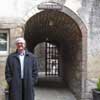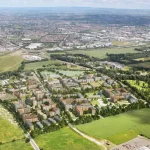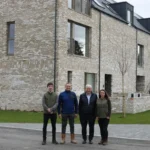Edinburgh News September 2013, Buildings in Scotland, Lothians Property Updates
Edinburgh News September 2013
Lothian Building Developments, Eastern Scotland
Edinburgh Building News – September 2013
Lothian Architecture Designs – latest additions to this page, arranged chronologically:
Charles McKean – 1946 to 2013
We were sad to learn that Charles McKean, Professor of Scottish Architectural History at the University of Dundee, has sadly passed away. He was formerly Secretary and Treasurer of the Royal Incorporation of Architects in Scotland. Anyone involved in Scottish Architecture will know of his excellent architectural guidebooks for Edinburgh and co-authored for Glasgow. He was born on July 16, 1946. He will be very sadly missed. 30 Sep
Here is the Obituary provided by the RIAS:
It is with very great regret that we write to notify you of the death of Professor Charles McKean Hon FRIAS 16.07.46 – 29.09.13. Charles served as Secretary and Treasurer of the Royal Incorporation from 1979 – 1994. During that time he transformed the organisation. As a prolific author, historian and media commentator and primarily through his role as Professor at Dundee, he made an immense contribution to the public and academic understanding of Scotland’s architectural history.
Charles McKean at Riddle’s Close:

photo (c) McKean Family
RIAS President Iain Connelly commented, ‘Charles McKean was an extraordinary and inspiring individual. His combination of infectious enthusiasm and immense erudition has helped transform Scotland’s attitude to our historic architecture. He shook up the Royal Incorporation during the 1980’s to create a vital and relevant organisation which continues to participate fully in the public life of Scotland. He was also a very nice man and a devoted husband and father. He will be profoundly missed by all those who knew him.’
Charles is survived by his wife, Margaret and his sons, Andrew and David.
Here is a link to the Fifth Annual Cockburn Lecture Delivered by Charles McKean in 2002, summarised by editor Adrian Welch.
In Richard DeMarco’s Vote of Thanks he said this:
“what a mess we’re in. In a funny way this lecture tonight was a call to arms”. McKean is “a man of integrity…he’s got no hope…he’s not afraid…Above all he is a man of passion…that’s what is needed now…He is a kind of leader”.
Lime mortar project to support Scotland’s most historic buildings
Scotland’s most historic buildings, along with 20 per cent of its housing stock, could benefit from a new research project into building conservation materials.
A new specification framework for lime mortars is being developed in a joint project between Heriot-Watt University and Historic Scotland. This could dramatically cut the cost of conserving and maintaining buildings like Edinburgh Castle, as well as generating business opportunities for small and medium enterprises (SMEs) throughout the country.
The majority of Historic Scotland’s buildings and around 500,000 houses in Scotland were built using lime mortars. From 1919, cement-based mortars became more popular. Cement mortars are generally incompatible with lime mortars and natural stone, meaning repairs and conservation attempts often fail.
The project has received £135,000 Knowledge Transfer Partnership (KTP) funding to work jointly on the ‘Limes-Quest’ project. This research will develop a new lime mortar framework, which will uncover the materials environmental and technical performance.
Roger Curtis, Historic Scotland technical research manager and project supervisor, said, “As the leading technical advisor in Scotland for repair and maintenance of historic buildings, we believe it is essential to better understand lime mortars and create a framework that be used across the country to ensure our buildings are cared for properly.
“Better understanding of lime mortars has the potential to create substantial savings. We estimate that our repair and maintenance costs across the 345 properties in our care could see a reduction as early as three years following the project.
“We should get better value for money through the use of more appropriate, greener materials, a reduction in the need to repeat conservation work, a reduction in revenue lost through visitor attractions having to close for maintenance and also through savings in grant aid for historic buildings throughout Scotland.”
Dr Alan Forster, academic supervisor from Heriot-Watt University’s School of the Built Environment, commented, “Lime mortars are regaining popularity because of their performance and green credentials. They actually absorb CO2, unlike cement. They are also more flexible and ‘breathable’ than cement mortars and so cope with moisture better, which is obviously of interest in Scotland given our weather.
“When they fell out of fashion in the early 1920s we forgot about the benefits of the use of lime mortars and their importance in constructing and repairing some of Scotland’s most iconic buildings. We need a comprehensive understanding of lime mortars so that we can prevent the deterioration of buildings and reduce the associated cost of repairs, including the time taken to try three or four different lime mortar ‘recipes’ on a structure.
“We will be testing various lime mortars’ physical strength, moisture handling characteristics and resistance to deterioration. We’ll also investigate how it reduces the carbon footprint of buildings and create a framework that can be used by Historic Scotland but will also be of value to architects, building merchants, local authorities and those generally entrusted with the repair of our traditional built environment.
“Homeowners who have had to repeatedly patch up their old homes with cement, only for it to cause problems such as rapid stone deterioration and dampness, will be aware of how beneficial this could be.”
Information published by Historic Scotland will help SMEs such as local binder and aggregate suppliers evaluate their products and promote them for regional works; raise awareness among architects and practitioners that greener and more compatible materials are available and also stimulate interest in traditional building skills. 30 Sep
Doors Open Days Edinburgh 2013

photo from The Cockburn Association
More images added of the buildings involved in Doors Open Day 2013
Scottish Construction Industry News
Stewart Milne Timber Systems comments on Scottish Government’s energy efficiency targets for the construction industry.
• New homes will have to reduce carbon dioxide emissions by approximately 21 per cent compared to current levels.
• New non-domestic buildings, such as shops and offices, will be required to decrease emissions by an average of around 43 per cent.
• The changes will be implemented in October 2015, a year later than first proposed.
Responding to the Scottish Government’s Building Standards announcement regarding energy efficiency targets for new builds, Alex Goodfellow, group managing director of Stewart Milne Timber Systems, said:
“We support the Scottish Government’s decision to extend the deadlines for the introduction of new energy efficiency standards and performance targets.
While zero carbon remains firmly on the Government’s agenda, the industry requires time to recover from the market downturn and find cost effective solutions to meeting these targets.”
“We firmly advocate a fabric first approach, employing sustainable materials in an innovative manner that is both cost effective for our house building clients and easy to implement.
“A fabric first approach enables house builders and construction companies to rely on the fabric of a building to provide the highest energy performance standards. We are already manufacturing systems that reach highest performance standards including BREAAM excellence.”
“This legislation provides the construction industry with a challenge and we’re working closely with our clients and R&D teams to deliver the means of meeting these new standards while keeping costs down.” 27 Sep
Miller Group News
Miller Group is considering a potential £400m flotation on the stock market to capitalise on the recovery in the UK housing market, according to reports. Earlier this month Scotland’s biggest housebuilder posted a 51 per cent increase in underlying first half profits to £14.2m, from £9.4m in the same period last year. 26 Sep
Scottish Energy Efficient Buildings News
New buildings in Scotland are to be more energy efficient when changes to the building standards come into effect in 2015, Minister for Planning, Derek Mackay has announced. From October 2015, improvement to new homes will reduce carbon dioxide emissions by around 21 per cent when compared to the current levels.
These measures will also affect new non-domestic buildings such as shops and offices where the improvement will be greater with an average reduction in emissions of around 43 per cent. 26 Sep
Deaconess House
The £14.5 m redevelopment of Deaconess House on The Pleasance, has topped out. The building will house over 300 new student apartments on the site of the former hospital. The original Deaconess House (dating back to 1894) is being retained and refurbished with the project set for completion in May 2014. A topping out ceremony has taken place to mark the building reaching its full height of 18.2m. 24 Sep
Our Island Home Design Competition
Rural Housing Scotland announce affordable island home design competition
A two stage open design competition to design a two bedroom house suitable for island locations which is affordable to build and heat. The objective of the competition is to help community landowners to use their land to enable the development of well designed warm, affordable housing for rent and ownership. The winning house to be built on community owned land in three island locations.
The Our Island Home competition, organised in conjunction with Architecture and Design Scotland, will create a house which is easy, quick and affordable to build and heat to help young islanders make new homes in their island communities, and help community landowners to use their land to build affordable housing for rent and ownership. The Our Island Home project is supported by the Prince’s Countryside Fund, ScotGrad and HIE.
At the reception in the Scottish Parliament to launch the competition, Lesley Riddoch, chair of the Judging Panel said “affordable housing is vital to enable young people to put down roots and help our island communities to blossom… look at Gigha, new affordable housing has helped the island’s population grow by nearly 50% since the community buyout in 2001.”
The closing date for the first stage of the competition is 11 November 2013 at 5pm. 24 Sep
Maggie’s Aberdeen Building News
This building opens today at Forester Hospital in Aberdeen, designed by Snohetta, the Norwegian architects behind the National September 11 Memorial Museum Pavilion in New York, alongside Aberdeen-based firm Halliday Fraser Munro. 24 + 23 Sep
City must build on Greenbelt
Property developers Murray Estates today insisted that the capital simply cannot build the new homes that it needs unless it agrees to major development on the Edinburgh greenbelt, reports the Edinburgh Evening News. The company, owned by Sir David Murray, wants to create a £1 billion Garden District development on land to the west of the city. Three thousand five hundred homes, a new high school, three primaries and a national garden attraction would be developed under the company’s plans for land beyond the bypass. 19 Sep
Edinburgh Trams
Edinburgh City Council has said its tram service will be operational by May 2014, following six years of construction work. 19 Sep
Scotland’s Resource Efficient House
Environment Secretary Richard Lochhead will officially open Scotland’s ground-breaking Resource Efficient House on Thursday September 19th.
The house has been built in a way which minimises the impact on the environment and also maximises affordability for developers. Mr Lochhead will be joined at the house in Ravenscraig by Iain Gulland, director of Zero Waste Scotland, Marissa Lippiatt from Resource Efficient Scotland, Alan Johnston from developers Tigh Grian Limited, and Rufus Logan, director of BRE Scotland.
Where: BRE Innovation Park at Ravenscraig, 2 Ravenscliff Road, Motherwell, ML1 1AE. 18 Sep
Queensferry Crossing
The world’s largest continuous underwater concrete pour has been achieved as foundation work for the huge 210 metre high Queensferry Crossing towers progresses. The concrete was delivered by barges from the batching plant at Rosyth dockyards. 18 Sep
Dundee Development News
The next major stage of Dundee’s £1 billion Waterfront redevelopment: councillors are to consider a £1.5 m demolition project for the current Dundee Rail Station. 18 Sep
Twitter chat to focus on Scottish Architecture
Culture Secretary Fiona Hyslop is to take to Twitter on Tuesday, September 24 for a live discussion on architecture and to seek tweeted views on how the Scottish Government should mark Scotland’s focus year in 2016.
It follows First Minister Alex Salmond’s announcement last Tuesday of Scotland’s new set of focus years- part of the legacy launched after the Year of Homecoming 2009, which spanned food and drink, active, creative, natural and ancestral themes.
2016 has been designated as a year in which Scotland’s achievements in innovation, architecture and design will be celebrated with a 12 month programme of events aimed at supporting and driving the nation’s tourism and events.
Ms Hyslop said:
“2016 presents a fantastic opportunity for Scotland to showcase to the world the incredible resource and skills that we have in our architects and designers.
“The year will also mark the 100th birthday of the Royal Incorporation of Architects in Scotland (RIAS) and the focus year theme is timed to coincide with a year-long RIAS Festival of Architecture.
“I am keen that we engage with the public and the profession to make sure we fully capitalise on this focus year. I want to reach out, not only to the architecture and design community but also to those who work in heritage and the digital sector – in fact, anyone who wants to share a view on how the visitor experience in 2016 can be enhanced and show off Scotland at its best.”
RIAS President, Iain Connelly, said:
“This is a great opportunity for our members throughout Scotland to put forward their views and make a valuable contribution to how Scotland should be promoted. The designated focus year and public engagement like this Twitter chat further emphasise the Scottish Government’s commitment to architecture as both a key driver of Scotland’s economy and as an art form in which Scotland has excelled throughout history, right up to the present day.”
Views collected via the Twitter chat will be used to help plan the format and celebrations to take place throughout 2016. The twitter chat with Ms Hyslop will take place between 1500 and 1600 on Tuesday September 24. To submit a question in advance tweet @culturescotgov using hashtag #Scotland2016. To find out more about ‘Creating Places’; the Scottish Government’s policy statement on architecture and place, visit www.creatingplacesscotland.org.
17 Sep
New Madras College
The new £40m Madras College in St Andrews have taken a step further with the submission of a planning permission in principle application. 17 Sep
Forth Bridge Experience

image from architect
Forth Bridge Experience
WT Architecture have been commissioned by Network Rail to develop early stage proposals for visitor facilities at the Forth bridge. There are two core proposals: a reception building for thrill-seekers undertaking a bridge walk from South Queensferry, and a visitor centre beneath the bridge tower in North Queensferry, which will also give access to a viewing platform on top of the bridge, accessed via a hoist. 13 Sep
National Performance Centre for Sport
Edinburgh wins. Scotland’s National Performance Centre for Sport will be located at the Riccarton Campus of Heriot-Watt University, west of Edinburgh. The £30m multi-sport facility designed by Reiach & Hall is being constructed to help Scotland’s athletes excel at elite level. The centre will offer high performance support for football, rugby and volleyball and be operational by 2016. Athletics, badminton, basketball, cricket, fencing, hockey and shinty will also receive assistance. Construction is due to start in the spring of 2014. 13 Sep
2016 : Scottish Year of Innovation, Architecture and Design
RIAS Delight as First Minister Announces 2016 as Year of Innovation, Architecture and Design
Thursday 12th September – Included in First Minister Alex Salmond’s announcement of Scotland’s focus years up to 2018, is the Government’s official designation of 2016 as the Year of Innovation, Architecture and Design.
RIAS President, Iain Connelly, said:
“This is a very welcome announcement. It further emphasises the Scottish Government’s commitment to architecture as both a key driver of Scotland’s economy and an art form in which Scotland has excelled throughout history, right up to the present day.”
While 2016 marks the centenary of the RIAS, the Year of Innovation, Architecture and Design will be much more than just a 100th birthday party. The RIAS centenary is really no more than a stepping off point. The Scottish Government’s designation of the year is a tremendous vote of confidence for an event designed to enhance participation in and understanding of our built environment.
2016 will raise awareness of the importance of a well-built environment and help inform communities throughout Scotland of the economic and social benefits of good architecture. The year will provide an opportunity to emphasise and celebrate the quality of our architectural heritage and contemporary design. It will also support Scotland’s ambitions as a player on the world stage.
The Year of Innovation, Architecture and Design will be celebrated throughout Scotland in events, creative commissions, school/community educational programmes, new online resources, touring exhibitions, pop-up architecture and competitions.
– Architecture accounts for over 10% of Scotland’s £2.67bn creative industries sector; In 2010, GVA for architecture in Scotland was £285m; In 2011, employment in architecture in Scotland was 5600.
Source: The Scottish Government Growth Sector Statistics Database, quoted in Creative Places, A policy statement on architecture and place for Scotland © Crown copyright 2013
– To date our partners in the Festival of Architecture 2016 are: A+DS; Aberdeen Society of Architects; Association of Preservation Trusts; Association of Scottish Schools of Architecture; Built Environment Forum Scotland; Children in Scotland; Creative Scotland; Dundee Institute of Architects; Edinburgh Architectural Association; Education Scotland; Event Scotland; Glasgow Institute of Architects; Historic Scotland; Institute of Historic Buildings Conservation; Inverness Architectural Association; Landscape Institute Scotland, National Galleries of Scotland; National Museums of Scotland; National Trust for Scotland; RCAHMS; Planning Aid Scotland; Royal Scottish Academy; Royal Town Planning Institute; The Saltire Society; The Scottish Civic Trust; The Scottish Government; Stirling Society of Architects; Visit Scotland; VOCAL.
Lino Factory Building
The world’s oldest linoleum factory will finally be demolished this autumn, after 20 years on the market. Scottish Enterprise has confirmed the former Nairn’s linoleum works in Kirkcaldy – a 120-year-old A-listed building – will be knocked down within weeks. 13 Sep
Meadowbank Building News
Reiach and Hall Architects have been appointed, as part of a project team, to carry out a feasibility study to draw up plans for the future of Meadowbank sports Centre and Stadium. Meadowbank is currently home to an eight-lane, 400m athletics track and a velodrome adjacent to the site. The venue also contains indoor facilities including squash courts, two sports halls, dance studios, an indoor football hall and gym facilities. Reiach and Hall are to help examine the options for enhancing these sporting facilities, understanding the important role that Meadowbank plays in the lives of thousands of people in the city and the significance of the venue to provide sports facilities in the East of Scotland. 11 Sep
‘Thinking Timbers’ evening lecture
The Wood Studio at Edinburgh Napier University is pleased to invite you to the next ‘Thinking Timbers’ evening lecture featuring Ian Hall at The Royal Society of Edinburgh on 30 September 2013 from 6.30pm.
Headed by architect, Ian Hall, Arkitrek manifests a very unusual approach to architecture – a social enterprise based in Malaysia, it has three distinct strings to its bow: commercial practice, research and development and experiential learning programmes. Its work is genuinely sustainable, in particular its approach to tropical passive design and the integration of architecture with social infrastructure and the natural environment. Arkitrek practices participatory design and engages with volunteers, students and communities in many of its projects. A graduate of Duncan of Jordanstone School of Architecture in Dundee, Ian will speak about the work of Arkitrek and the timber projects he has been involved in over the past ten years. If you’re looking for something new or different to learn about architecture and construction, this talk should certainly stimulate discussion.
Registration will commence at 6pm and the lecture will commence at 6.30pm.
Register your place through wpig(at)napier.ac.uk
Scottish Water National Operations Centre
Scottish Water’s new build National Operations Centre designed by Reiach & Hall has been formally completed, reports Urban Realm today. The 6,400 sqm building in Stepps uses a simple palette of blonde brick and glazing with cast stone string courses and bronze anodised aluminium curtain walling. Turner & Townsend were project managers. 10 Sep
Dundee Jute Mill News
A historic Dundee jute mill which was earmarked for demolition due to its badly deteriorated condition is now on course for a £2.23 m renovation as a tourist attraction. Thanks to the efforts of a small fundraising team, plus grants from Historic Scotland and the Heritage Lottery Fund, along with a six-figure bequest from a mystery benefactor, the A-listed Verdant High Mill will come alive again within two years. The fundraising target, which began in 2012 to raise a shortfall of £250,000 for the project, is now only £70,000 short of its target, Dundee Heritage Trust director Mark Munsie told The Courier. Work is due to start in Spring 2014 with an estimated 18-month build program. 10 Sep
RSA Architecture Open
CALL TO ARCHITECTS – RSA ARCHITECTURE OPEN 2013
Deadline for submission of works: Monday 7th October
RSA Architecture Open : Info & Entry forms / regulations – external link
Following the great success of the RSA’s first ever Architecture Open exhibition last year, the Academy is delighted to announce details for the 2013 Open exhibition.
Architects from all over Scotland and further afield are encouraged to submit models, drawings and other media to this open submission exhibition, led by convenor Richard Murphy OBE RSA.
“The RSA Open Exhibition is THE annual opportunity to take the temperature of architecture in Scotland. It Is a snapshot of the best of architectural activity happening here and in one room we hope we will see most interesting current work from all of Scotland’s best architects’ together with talent that might hitherto be not so well known.
Architecturally Scotland punches well above its weight and I am determined that the exhibition will demonstrate this by both the quantity of submissions and the high quality of the projects selected. And finally, it is vital that although the show does not open until 23rd November, all architects considering submitting work should be well aware of the 7th OCTOBER deadline for online registration of work.” Richard Murphy OBE RSA.
The Academy has a long history of supporting architecture in Scotland and looks forward to continuing this with RSA Architecture Open 2013. Further information about the exhibition and the submission process can be found on the RSA’s website – please click on the following link: http://bit.ly/14mbe7e
Twitter hashtag: #RSAopen
Rosslyn Chapel Building News
Rosslyn Chapel Restoration
A 16-year project to restore Rosslyn Chapel has come to an end, with the last piece of scaffolding removed from the building. 5 Sep
Japanese-style garden at Cowden
Unique Japanese-style garden at Cowden recognised for its national importance.
It is among the few surviving sites of its kind in the United Kingdom – and now the privately-owned, early twentieth century Japanese-style Garden at Cowden in Clackmannanshire has been recognised for its national importance as the most recent addition to Historic Scotland’s Inventory of Gardens and Designed Landscapes – more info + photos on the Glasgow Architecture news. 5 Sep
Edinburgh Architects + Designers in China
Shanghai ZhangDaQian, China – building news – 4 Sep 2013
Design: Sutherland Hussey Architects with GROSSMAX.
The program, apart from the gallery itself, includes a 200 seat lecture hall, meeting rooms, book shop and cafe, restoration facilities, storage and archiving space all organised into small pitched roof cellular forms wrapping around courtyards of varying size containing neatly manicured gardens, carp ponds and bamboo forests. The gallery is also to include a Michelin star restaurant run by a top British chef, looking out over the park and a traditional Chinese garden. The gallery is designed to BREAM energy standards and is anticipated to start on site in 2014.
Pedestrianisation in the Capital
The car-free Festival zone on George Street has been declared a resounding success – paving the way for new pedestrian-friendly projects in the city centre, reports the Edinburgh Evening News today. The number of people visiting George Street leapt by a third compared to last August and also halved the amount of traffic. The George Street shake-up – that saw cafes replace vehicles along large stretches of the road – now looks set to continue for at least the next three festivals.
City leaders also believe their controversial bid for a one-way loop in the centre has been vindicated by George Street’s success as a “people space”. The pedestrian-friendly master-plan would see buses and public transport run along the north side of George Street and westbound on carriageways on Princes Street – to allow pavements to be extended for pedestrians.
I tried to walk through the central space with my children (early evening) but we were advised we weren’t allowed in due to licensing. The security staff were pretty unfriendly to us and also to other people both at the Assembly Room entry and the eastern entry. There should be some solution to this – Adrian Welch, editor. 2 Sep
Edinburgh Building News – news in full from August 2013
Architecture in Lothian
Contemporary Architecture in the Lothians
Edinburgh Building News Summary
Comments / photos for Edinburgh Architectural News for September 2013 page welcome



